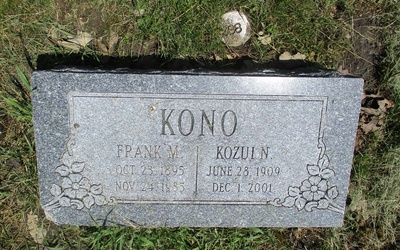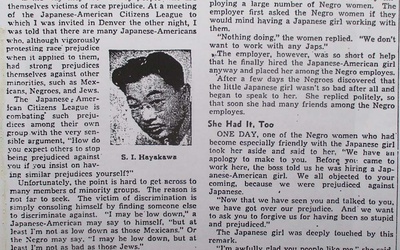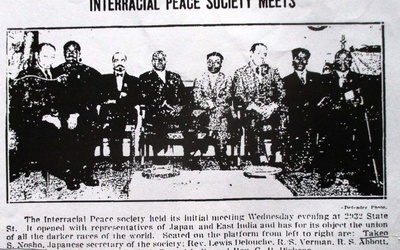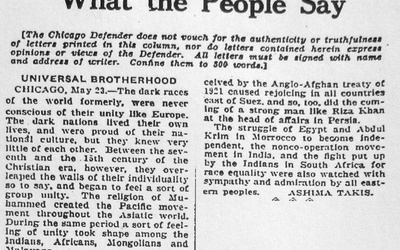Suspicious Points of Contact in Pre-War Chicago

This series tells the stories of Japanese and Japanese Americans in Chicago and the Midwest prior to and during World War II, stories that were very different from those of Japanese on the West Coast. Although the Japanese population, along with the number of Japanese arrested by the FBI right after the war broke out, were both small (less than 500 and 20 respectively), the US government’s watchful eyes had been suspicious of Japanese government espionage carried out by Japanese Chicagoans who had daily contact with African Americans since the 1930s. The series focuses on the lives of four Japanese in Chicago and the Midwest who were arrested on suspicion of espionage.
Stories from this series
Japanese Affinity with African American Communities - Part 5
Jan. 9, 2022 • Takako Day
Read Part 4 >> Frank Masuto Kono When he heard about the Pearl Harbor attack, Frank Kono (the Issei who served as the secretary-treasurer of the Japanese Mutual Aid Society in Chicago and was arrested in 1943 with three other Japanese) was working at his restaurant, the Indiana Restaurant, at 4248 South Indiana Avenue in Chicago.1 Soon thereafter, the FBI came and searched Kono’s house not once but twice, and he was called in by the FBI and the Immigration and Naturalization …
Japanese Affinity with African American Communities - Part 4
Jan. 2, 2022 • Takako Day
Read Part 3 >> Samuel Ichiye Hayakawa and the Chicago Defender A brilliant scholar of semantics, English professor, poet, historian of Chicago jazz, and U.S. senator, S. I. Hayakawa was the first non-African American to write a series of columns for the Chicago Defender.1 In November 1942, the Defender announced five new columnists and S.I. Hayakawa, who was professor of semantics at the Illinois Institute of Technology at the time, was one of them.2 When he was offered the opportunity …
Japanese Affinity with African American Communities - Part 3
Dec. 26, 2021 • Takako Day
Read Part 2 >> Sociologist Tadao Kawamura and the University of Chicago It is not known at this point whether Harry Jitsuzo Harada (the journalist who wrote to Booker T. Washington asking his opinion about Japanese immigration on December 15, 1919) ever completed his book on African Americans, but Tadao Kawamura actually did. Kawamura was a sociologist trained at the University of Chicago and his book, American Negro no Kenkyu (Research on American Negros) was considered the first Japanese book …
Japanese Affinity with African American Communities - Part 2
Dec. 19, 2021 • Takako Day
Part 1 >> Booker T. Washington, Marcus Garvey, and Jitsuzo Harada in Chicago Tuskegee Institute in Alabama, founded by Booker T. Washington in 1887, was well-known by certain Japanese because “Japanese who had read Up from Slavery in translation saw in Tuskegee methods one of the means of overcoming their nation’s technological lag behind the West” and Tuskegee was “a mecca for not only Africans but West Indians and Asians.”1 The first Japanese student at Tuskegee, who enrolled “as part …
Japanese Affinity with African American Communities—Part 1
Dec. 12, 2021 • Takako Day
Introduction In December 1943, when loyal Japanese Americans were leaving concentration camps and relocating to cities in the Midwest such as Chicago, Cleveland, and Kansas City, four Japanese Issei men were arrested in Chicago by the FBI. They were Charles Yasuma Yamazaki and Frank Masuto Kono, who had been Chicago residents for more than twenty years, and Soyu Matsuoka, a Buddhist priest, and Robert Hajime Shiomi, a medical doctor from Oregon. Matsuoka and Shiomi were new to Chicago. Matsuoka came …
The Japanese Consulate and Naka & Pearl Nakane - Part 2
Aug. 20, 2019 • Takako Day
Read Part 1 >> Naka and Pearl Nakane and Chicago Did Naka Nakane ever come to Chicago? How much political influence did he have in Illinois? Did the Japanese consulate in Chicago somehow get involved in Nakane’s “black maneuver” in the Midwest? All that can be said at this point is that two documents purporting to be pledges from the Development of Our Own were found among others in a search of the former Japanese consulate in Chicago.1 The Development …








